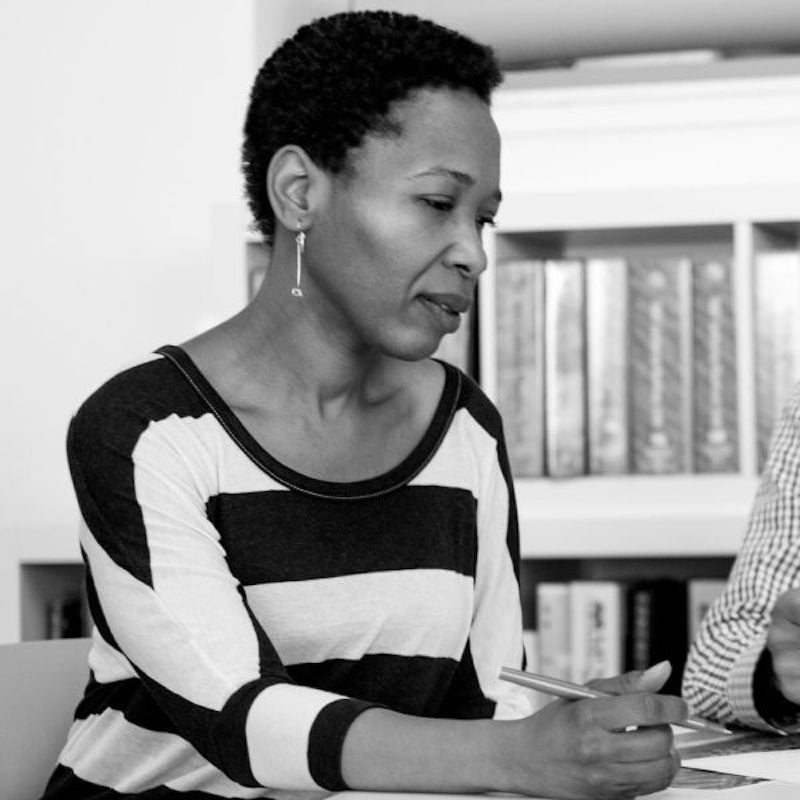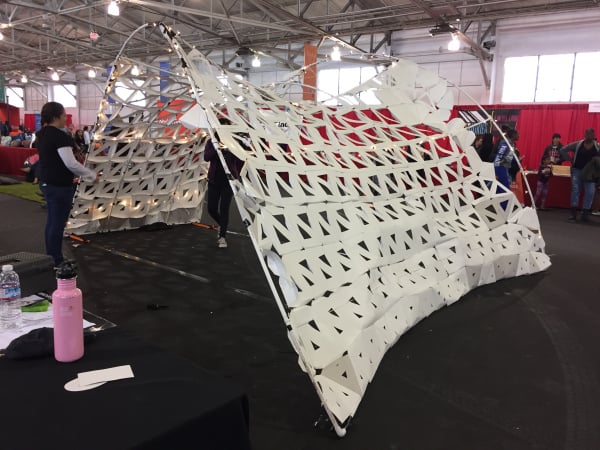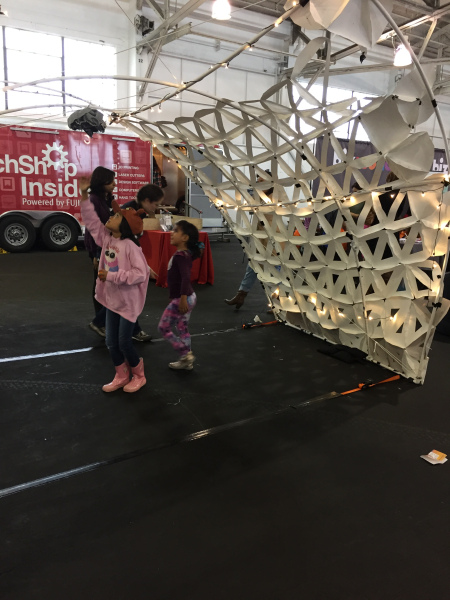
This article originates from Women In 3D Printing and is part of our effort to support the use of 3D printing technology by women. The article is re-published with permission.
June Grant founded blink!LAB architecture as an integrated design, research and fabrication practice committed to the craft of buildings and solving real world problems.
Their work is informed by the exploration of digital fabrication technologies. Those who attended this Saturday’s Girls’ Festival in Fort Mason saw the results of what June is able to put together, through her Geometry Pavillon installation.
Nora Toure: June, could you share with us your first experience with 3D Printing?
June Grant: I have a passion for all things complex. I’m also fiendish about precision. There is a distance between the design (on paper) and the actual making that I always thought of annoying. Especially as it relates to complex shapes. It was at one of the many conferences or workshops that I attended that the two instructors for Rhino3d and TypeA Machines had teamed to present a grasshopper 3d workshop. That was possibly 2013 when I first worked directly with one of the desktop machines. The simplicity was genius and the ability to repair or hack to expand was perfect. As a designer, that flexibility and freedom were exactly what reduced the design-to-fab gap. The ability to prototype at scale, with precision and at incredibly low cost was the triple whammy the designer-marker had been waiting on. I ordered a TypeA Machine within a month after that workshop. Prior to that, I had primarily interacted through online services and fabricator shop visits.
Nora Toure: How often and how do you use 3d printing in your architectural project?
June Grant: The machine runs daily and, most often, over night. The print jobs and reason varies. You might think that I would use it for 3d printed scale buildings but I do not. Instead, the printer is used for essentially anything with complex curves. And often times the same print run is stopped mid-run. This is so I have almost a progress collection of maquettes that reveals various sections of the object. As much as I am interested in the final print, in order to understand the form, I have to “record” progressive growth stages of the form. Frequently, those partial prints yield stunning shapes.

Nora Toure: Why use 3D printing in those project?
June Grant: For some reason, no matter what the project, I insist on lighting the 3D-object. It’s possible the reason is I have to imagine life inside the form. There is something about the scale of the 3d-printed object that creates almost a fetish, a need to animate its solidity. I am also acutely aware of the waste that is associated with 3D-printing depending on the source material. For that reason, I have become more discerning and deliberate about when and how the 3d printer is used. Currently, I am exploring mixed-material assemblies. Each material is (hopefully) used for its best purpose. For example, Geometry Pavilion is essentially a surface that curves in three directions. The entire thing could be 3d printed. But why? That would be interesting but would not result is the goal I’m attempting to achieve which is integrate group or social engagement. It would also require many machines and defeat the purpose of critical thinking. As a result, the majority of the structure can be assembled from items readily available from the local hardware or art store. However, some joints require more freedom of movement, rotation beyond 90degrees. The only way to meet the precise needs of those intersections where directional curvature changes is to custom fabricate the part needed.
Nora Toure: You are part of WorldWideWomen and worked on the beautiful main installation in the Maker’s Space of the Girls’ Festival. Why was joining WorldWideWomen important for you?
June Grant: Linda Calhoun, who I have known for a few years, and I both share a singular dream – to achieve greater recognition and exposure of women to a wider audience. She knows I am particularly concerned with the lack of black (the entire Diaspora) women in architecture. I am one of only 370 licensed black female architects in the entire United States. Let that number sink in. We are 0.2% percent of the total number of practicing architects in the country. We are not a new phenomenon, there have been licensed black architects in the US for almost 100 years. Given the low numbers, it is important for me to encourage African American girls to consider design; to be a part of a group of people who actually transforms environments. Secondly, getting involved is essential so that others become aware that we exist and we are varied. When Linda calls I never say no. She is one of my greatest cheerleaders.

Nora Toure: Could you tell us more about the installation you worked on?
June Grant: Geometry Pavilion is really an homage to myself as a child. I was the little girl who wanted the chemistry set, not the doll. I was the one on the skateboard trying tricks, not just watching. The design is purely for the girl who likes geometry; the girl who might not have an outlet to exercise that passion. Coding and 3D printing are fantastic contemporary realms, but being able to first imagine complete shapes and create them without machinery, I think is one of those really simple things that one can do anywhere and with anyone. All it takes is paper and glue.
Nora Toure: What were the challenges you encountered in building such an installation?
June Grant: Because I had set the ground rules that only off-the-shelf items would be allowed, there really have not been any significant hurdles. Initially, I was concerned that the required installation time might be extensive. So I cut and assembled a paper mock-up at 1”=1’ scale. It took 4 hours. So verifying assembly time was a relief. The most grueling has been laser-cutting each shape; a total estimated time of 49 hours. My two concerns are first, directing traffic (ie participants) on the process of assembling the parts. The structure itself is composed of over 250 unique shapes. Attention to details is essential. The other concern is wind. The pavilion is extremely light. It can be lifted by one person. It has the potential to be a nightmare or a beautiful success.
Nora Toure: What was the most impressive or impactful use of 3D printing you’ve seen so far?
June Grant: I think the impact in the medical profession has been incredible – with devices for the heart. However, one of my favorite results has to be the ability to 3d print prosthetics for children. Not only are we now able to customize, we are able to account for growth and best is the children are able to express their own the aesthetic sensibility.
Nora Toure: What makes the 3D printing industry particularly interesting for you?
June Grant: As a designer, my 3d printer is just as essential as my computer. My work is severely hampered without the ability to see and touch the proposal. Proof of concept through physical exhibition is critical for me to understand and agree that my idea is the correct solution to a given need.
As a business woman, I would have to say that the average client (and citizen) still considers the 3D printer as a “cool thing”. But the moment clients and friends see it in operation, just its very act of printing, it never fails, the next question is “Can you make…”. That’s the best impact – the printer sparks the client’s imagination of new possibilities.
Nora Toure: What do you think of the 3D printing industry today? And how would you like to see it evolve?
June Grant: I used to think it would change the architecture industry massively, although I have to admit I did not know how. Model making is an immediate applied use; not an industry shift. Where I am very interested now are material structure and dye-molds. Weaving of threads to create needed cable or rope. This falls under the “wouldn’t it be cool if I could” category; meaning I’ll get to this later. However closer in the time-frame of immediately possibility, is being able to print custom molds or custom-panel skins for buildings. That’s one of the next prototyping projects, prototyping a variable surface meant for the exterior of a building.
Nora Toure: In your opinion, how could we encourage more women to become involved with 3D Printing?
June Grant: Appeal to their sense of freedom and problem solving. Most individuals I know solve multiple problems daily, or have multiple projects that have sat because they did not have the tool or skill to create the solution. I find it disturbing the amount of pink I see in advertisements. It re-enforces a stereotype – girls wear pink. No, girls wear a singular color because it is being proposed consistently without challenge. The message limits exposure. To my mind, 3D printing becomes more attractive to women and girls when the message and application is varied and promotes exploration, mess and success.
If you are interested in learning more about June, I invite you to check blink!LAB architecture !
And don’t forget to join the Women in 3D Printing group on LinkedIn and Facebook. You can also show your support by donating – Your support will help maintaining the activities of this blog and building more events for the community.
Thank you for reading and for sharing!

